六、用 go 语言,说明如果红黑树的表示中不提供父指针,应当如何有效地实现 RB-INSERT。
文心一言:
红黑树是一种自平衡的二叉搜索树,其中每个节点都包含一个颜色属性(红色或黑色),并且满足以下性质:
节点是红色或黑色。根节点是黑色。所有叶子节点(NIL 或空节点)都是黑色。如果一个节点是红色的,则它的子节点都是黑色的。从任一节点到其每个叶子节点的所有路径都包含相同数目的黑色节点。在红黑树的表示中,通常会为每个节点提供一个父指针,这样在插入或删除节点时可以方便地找到父节点。但是,如果没有提供父指针,实现 RB-INSERT 操作将会稍微复杂一些。
在这种情况下,我们需要使用递归来实现 RB-INSERT 操作。以下是一个使用 Go 语言实现的示例:
type Node struct { Key int Color string Parent *Node } type RedBlackTree struct { Root *Node } func (t *RedBlackTree) Insert(key int) { newNode := &Node{Key: key, Color: "Red"} parent := t.Root if parent == nil { newNode.Color = "Black" // 根节点必须是黑色的 t.Root = newNode return } current := parent for current != nil { parent = current if newNode.Key < current.Key { current = current.LeftChild() } else { current = current.RightChild() } } newNode.Parent = parent if newNode.Key < parent.Key { parent.LeftChild(newNode) } else { parent.RightChild(newNode) } t.FixInsert(newNode) // 修复红黑树性质 } func (n *Node) LeftChild() *Node { if n == nil { return nil } else if n.Left != nil { return n.Left } else if n.Right != nil { return n.Right } else { return nil // 叶子节点或NIL节点没有左孩子,返回nil } } func (n *Node) RightChild() *Node { if n == nil { return nil } else if n.Right != nil { return n.Right } else if n.Left != nil { return n.Left } else { return nil // 叶子节点或NIL节点没有右孩子,返回nil } } func (n *Node) LeftChild(newNode *Node) { if n == nil { // NIL节点作为父节点的情况,需要特殊处理左孩子和右孩子的设置,这里省略处理细节... } else if n.Left == nil { // 普通设置左孩子的情况,这里省略处理细节... } else if n.Right == nil { // 普通设置右孩子的情况,这里省略处理细节... } else { // 普通设置左右孩子的情况,这里省略处理细节... } } func (n *Node) RightChild(newNode *Node) { // 与设置左孩子类似,这里省略处理细节... }
复制代码
讯飞星火:
红黑树是一种自平衡的二叉查找树,它通过维护节点的颜色和旋转操作来确保树的高度始终保持在 log(n)。在红黑树中,每个节点都有一个颜色属性(红色或黑色),并且每个节点都有两个子节点(左子节点和右子节点)。
红黑树的插入操作(RB-INSERT)的基本步骤如下:
将新节点插入到普通二叉搜索树中。
如果新节点是根节点,将其颜色设置为黑色。
否则,从新节点开始向上遍历树,对每个经过的节点执行以下操作:
如果当前节点是红色,将其颜色更改为黑色,并将其父节点和祖父节点的颜色更改为红色。然后根据祖父节点的位置进行相应的旋转操作。
将根节点的颜色设置为黑色。
由于题目要求不提供父指针,我们可以使用一个额外的数据结构(如链表)来存储每个节点的父节点。这样,在执行插入操作时,我们可以通过遍历这个链表来找到每个节点的父节点。
以下是用 Go 语言实现 RB-INSERT 的代码:
package main
import "fmt"
type Node struct { key int color string left *Node right *Node}
func insert(root *Node, key int) *Node { node := &Node{key: key, color: "red", left: nil, right: nil}
if root == nil { return node }
parent := findParent(root, key) if parent.key > key { parent.left = node } else { parent.right = node }
fixInsert(node) return root}
func findParent(root *Node, key int) *Node { if root == nil || root.key == key { return nil }
if root.key > key { return findParent(root.left, key) }
return findParent(root.right, key)}
func fixInsert(node *Node) { for node != nil && node.color == "red" { if node.parent.color == "red" { node.parent.color = "black" node.grandparent.color = "red" node = node.grandparent } else if node == node.parent.left && node.parent.parent.color == "red" { node = node.parent.parent rotateRight(node) } else if node == node.parent.right && node.parent.parent.color == "red" { node = node.parent.parent rotateLeft(node) } else { break } }
root.color = "black"}
func rotateLeft(node *Node) { temp := node.right node.right = temp.left temp.left = node}
func rotateRight(node *Node) { temp := node.left node.left = temp.right temp.right = node}
func main() { root := nil root = insert(root, 10) root = insert(root, 20) root = insert(root, 30) root = insert(root, 40) root = insert(root, 50) root = insert(root, 25)
fmt.Println("Root color:", root.color)}
复制代码
这段代码首先定义了一个Node结构体,用于表示红黑树中的节点。然后实现了insert函数,用于插入新节点。findParent函数用于查找给定键的父节点。fixInsert函数用于修复插入操作后可能导致的红黑树性质破坏的情况。最后,rotateLeft和rotateRight函数分别实现了左旋和右旋操作。
360 智脑:
在 Go 语言中,红黑树是一种自平衡二叉查找树,它提供了高效的数据查找和插入操作。在红黑树的实现中,通常会使用一个节点指针来指向父节点,以便在插入和删除操作中维护树的平衡性。但是,如果红黑树的表示中不提供父指针,我们仍然可以通过一些技巧来实现 RB-INSERT 操作。
以下是一个在不提供父指针的情况下实现 RB-INSERT 的方法:
首先,我们需要在每个节点中增加一个额外的“标记”字段,用于记录节点的父节点。这个标记可以是一个整数值,表示节点的深度,或者是一个指向最近祖先节点的指针。
在插入新节点时,我们首先执行常规的二叉查找树插入操作。然后,我们需要找到新节点的最近祖先节点,可以通过递归遍历树的深度来实现。在这个过程中,我们可以使用一个栈来存储节点的路径,以便在找到最近祖先节点后,可以通过栈弹出操作来找到祖先节点。
找到最近祖先节点后,我们需要执行红黑树的旋转操作来维护树的平衡性。这时,我们需要知道旋转的类型(左旋或右旋)以及旋转的节点。通常情况下,我们可以通过判断新节点和其父节点的颜色以及它们在树中的位置来确定旋转的类型。但是,在不提供父指针的情况下,我们可以通过以下方法来确定旋转类型:
执行旋转操作后,我们需要更新树中节点的颜色和深度,并继续向上遍历树,直到找到根节点或找到一个黑色节点。在这个过程中,我们需要将新节点的颜色设置为红色,并更新每个节点的深度。
最后,我们需要更新根节点的颜色和深度,并完成 RB-INSERT 操作。
总之,在不提供父指针的情况下,我们仍然可以通过增加额外的标记字段和使用栈来实现 RB-INSERT 操作。但是,这种方法比使用父指针的方法更加复杂和低效。因此,在实际应用中,我们通常会使用父指针来简化红黑树的实现。
智谱清言:
在 Go 语言中,如果红黑树的表示中不提供父指针,实现 RB-INSERT 算法需要依靠某些辅助结构来有效地查找和修改节点。以下是一种可能的实现方法:
引入一个栈(stack)来存储从根节点到待插入节点 z 的路径。在插入过程中,每当访问一个新节点,就将它压入栈中。
定义一个链式栈(linked stack),其节点类型为snode,包含一个node类型的数据域和一个指向下一个节点的指针。
使用stack结构体来表示栈,其中包含一个指向栈顶节点的指针。
实现StackInsert和StackPop函数来分别向栈中插入元素和从栈中弹出元素。
在进行 RB-INSERT 操作时,首先将根节点压入栈中。然后,从栈顶节点开始,执行以下操作:a. 如果当前节点为空,或者待插入节点 z 的键已经存在于当前节点,则结束插入操作。b. 如果当前节点的左子节点为空,将待插入节点 z 作为左子节点插入到当前节点。设置 z 的父节点为当前节点,并将 z 的颜色设置为红色。然后更新红黑树的性质,并进行必要的旋转操作。c. 如果当前节点的右子节点为空,将待插入节点 z 作为右子节点插入到当前节点。设置 z 的父节点为当前节点,并将 z 的颜色设置为红色。然后更新红黑树的性质,并进行必要的旋转操作。d. 如果当前节点的左右子节点都不为空,说明当前节点是待插入节点 z 的祖先节点。将当前节点从栈中弹出,并将栈顶节点(即当前节点的父节点)移动到栈顶。重复步骤 5。
完成上述步骤后,如果栈中仍有元素,说明存在违反红黑树性质的情况。此时,需要通过旋转操作来修复红黑树的性质,直至栈为空。通过以上方法,即使红黑树的表示中不提供父指针,我们也可以有效地实现 RB-INSERT 算法。需要注意的是,这里只提供了一种可能的实现方法,具体的实现细节可能会因不同的应用场景和需求而有所差异。
通义千问:
在红黑树的表示中,如果选择不存储父节点指针(parent pointer),插入新节点(RB-INSERT)时需要采取一种间接的方式来跟踪和更新父节点。由于红黑树要求保持特定的性质(如节点是红色或黑色、任何路径上从根到叶子节点的黑节点数量相同等),在插入过程中可能需要进行旋转和重新着色操作,而这些通常涉及父节点。
为了在没有父指针的情况下实现 RB-INSERT,可以采用栈来记录从根节点到待插入节点路径上的所有中间节点。具体步骤如下:
初始化:
创建一个栈 path 来存储节点。
从根节点开始遍历红黑树。
查找插入位置:
遍历树的过程中,将经过的节点依次压入栈中。
当找到待插入位置(即小于等于新节点的所有节点都在其左侧,大于新节点的所有节点在其右侧的位置)时停止遍历。
插入新节点:
将新节点插入到找到的位置,作为当前栈顶节点的孩子节点。
新节点初始颜色设为红色。
修复红黑树性质:
弹出栈顶元素作为新节点的父亲节点,并检查红黑树的性质是否被破坏。
使用栈来追踪祖辈关系,并执行相应的旋转和重新着色操作以恢复红黑树的性质,例如:
如果新插入节点是红色且其父节点也是红色,那么违反了红黑树的“红节点不能连续”规则,需要通过旋转和变色来调整。
根据新节点与父节点以及祖父节点的关系,执行左旋、右旋或者左右旋(先左后右)。
完成插入:
调整完树结构并确保所有红黑树性质满足后,结束插入过程。
以下是简化后的伪代码描述:
func RBInsert(tree *Rbtree, value int) { var node *Node = &tree.sentinel // 哨兵节点作为起始点 var parent *Node = nil // 初始化父节点为 nil var path []*Node // 创建用于保存路径的栈
for { parent = node if value < node.value { // 左子树方向 node = node.left if node == tree.sentinel { // 找到插入位置 break } } else { // 右子树方向 node = node.right if node == tree.sentinel { break } } path = append(path, node) // 将节点压入栈 }
newNode := &Node{value: value, color: RED} if value < parent.value { parent.left = newNode } else { parent.right = newNode }
newNode.parent = parent // 即使不存储在结构体中,这里仍需临时设置以便于接下来的操作
// 修复红黑树性质 FixRedBlackTreeProperties(tree, newNode, path)
// ...}
// FixRedBlackTreeProperties 是一个虚构函数,它会根据实际情况执行旋转和变色操作来修复红黑树性质func FixRedBlackTreeProperties(tree *Rbtree, insertedNode *Node, path []*Node) { // 这里实现旋转和变色逻辑}
复制代码
请注意,实际的 Go 语言实现会更加复杂,包括实现修复红黑树性质的具体逻辑。在修复过程中,即使没有显式的父指针,也可以利用栈中的信息推断出需要调整的节点之间的关系。
天工:
在 Go 语言中,如果红黑树表示中不提供 parent 指针,我们可以使用以下方法来实现 RB- INSERT:
定义一个节点类型,包含 key、value、color、parent 和 left、right 指针。
在插入节点时,首先判断新节点的颜色是否为黑,如果是黑则直接插入节点,否则需要对节点进行旋转操作。
插入节点后,需要对节点的颜色进行重新着色,保证树的平衡性。
下面是一个实现 RB-插入的示例代码:
type Node struct { Key int Value int Color byte Parent *Node Left *Node Right *Node}
func (n *Node) rotateLeft() { x := n.Right n.Right = x.Left if x.Left != nil { x.Left.Parent = n } x.Parent = n.Parent if n.Parent != nil && n == n.Parent.Left { n.Parent.Right = x } else { n.Parent.Left = x } x.Left = n}
func (n *Node) rotateRight() { y := n.Left n.Left = y.Right if y.Right != nil { y.Right.Parent = n } y.Parent = n.Parent if n.Parent != nil && n == n.Parent.Right { n.Parent.Left = y } else { n.Parent.Right = y } y.Right = n}
// 插入节点func RBInsert(n *Node, key int) { if n == nil { return } if key < n.Key { n.Left = RBInsert(n.Left, key) if n.Left != nil { n.Left.Color = 'R' } } else if key > n.Key { n.Right = RBInsert(n.Right, key) if n.Right != nil { n.Right.Color = 'R' } } else { n.Key = key n.Color = 'R' }}
复制代码
在上述代码中,我们通过 rotateLeft() 和 rotateRight() 方法来实现节点的旋转操作,保证树的平衡性。在插入节点时,我们先判断节点的颜色是否为黑,如果是黑则直接插入节点,否则需要对节点进行旋转操作。插入节点后,我们需要对节点的颜色进行重新着色,保证树的平衡性。
灵小智:
如果在红黑树的表示中不提供父指针,我们可以通过其他方式有效地实现RB-INSERT算法。这里我将使用Go语言来演示具体实现。
复制代码
首先,我们需要定义红黑树的节点结构体,包含键值、颜色、左子节点和右子节点等属性:
type Node struct { key int color string left *Node right *Node}
复制代码
接下来,我们实现 RB-INSERT 算法。由于没有父指针,我们需要借助递归来定位插入位置,并在递归过程中保持对祖先节点的颜色状态。
func RBInsert(root *Node, key int) *Node { if root == nil { return &Node{key: key, color: "RED"} }
if key < root.key { root.left = RBInsert(root.left, key) if root.color == "RED" { return root } if root.left.color == "RED" && isRed(root.left.left) { return fixLeftLeftCase(root) } if root.left.color == "RED" && isRed(root.left.right) { return fixLeftRightCase(root) } } else if key > root.key { root.right = RBInsert(root.right, key) if root.color == "RED" { return root } if root.right.color == "RED" && isRed(root.right.right) { return fixRightRightCase(root) } if root.right.color == "RED" && isRed(root.right.left) { return fixRightLeftCase(root) } }
return root}
复制代码
在 RBInsert 函数中,我们首先根据键值的大小选择递归向左子树或右子树插入。然后,根据祖先节点和当前节点的颜色关系执行相应的修复操作,这里假设存在 fixLeftLeftCase、fixLeftRightCase、fixRightRightCase 和 fixRightLeftCase 等修复函数来处理不同情况下的平衡恢复操作。
最后,我们可以使用 RBInsert 函数将新节点插入红黑树中:
func main() { var root *Node
// 插入节点 root = RBInsert(root, 10) root = RBInsert(root, 20) root = RBInsert(root, 30) root = RBInsert(root, 15) root = RBInsert(root, 17) // 继续插入其他节点...
// 打印红黑树 printTree(root)}
func printTree(root *Node) { if root != nil { printTree(root.left) fmt.Printf("%d:%s ", root.key, root.color) printTree(root.right) }}
复制代码
这样,我们就成功通过递归和状态维护来实现了在不提供父指针的情况下进行 RB-INSERT 操作的红黑树实现。注意,为了简化代码,这里省略了一些边界条件检查和其他函数的具体实现部分,但核心思想是一致的。
希望这可以帮助到你!如有任何疑问,请随时提出。
chatgpt:
在红黑树的表示中,如果不提供父指针,可以通过迭代来实现 RB-INSERT。下面是使用 Go 语言实现红黑树的 RB-INSERT 算法的示例代码:
type Node struct { key int color string // "RED" or "BLACK" left *Node right *Node}
func RBInsert(root *Node, key int) *Node { newNode := &Node{key: key, color: "RED"}
if root == nil { newNode.color = "BLACK" return newNode }
var parent, current *Node
parent = nil current = root
for current != nil { parent = current
if newNode.key < current.key { current = current.left } else { current = current.right } }
newNode.parent = parent
if newNode.key < parent.key { parent.left = newNode } else { parent.right = newNode }
fixupRedBlackTree(newNode)
return root}
func fixupRedBlackTree(node *Node) { if node.parent == nil { // Case 1: The node is the root of the tree. node.color = "BLACK" return }
for node.parent.color == "RED" { // Case 2 and Case 3: Parent is RED. if node.parent == node.parent.parent.left { // Parent is a left child. uncle := node.parent.parent.right
if uncle != nil && uncle.color == "RED" { // Case 2: Uncle is also RED. node.parent.color = "BLACK" uncle.color = "BLACK" node.parent.parent.color = "RED" node = node.parent.parent } else { // Case 3: Uncle is BLACK or NIL. if node == node.parent.right { node = node.parent leftRotate(node) }
node.parent.color = "BLACK" node.parent.parent.color = "RED" rightRotate(node.parent.parent) } } else { // Parent is a right child. uncle := node.parent.parent.left
if uncle != nil && uncle.color == "RED" { // Case 2: Uncle is also RED. node.parent.color = "BLACK" uncle.color = "BLACK" node.parent.parent.color = "RED" node = node.parent.parent } else { // Case 3: Uncle is BLACK or NIL. if node == node.parent.left { node = node.parent rightRotate(node) }
node.parent.color = "BLACK" node.par
复制代码
kimi:
在红黑树的表示中,如果节点没有父指针,实现 RB-INSERT 操作会变得更加复杂,因为我们需要能够找到新插入节点的父节点以及祖先节点来执行旋转和颜色调整。以下是一个可能的方法来实现 RB-INSERT,即使没有父指针:
在插入新节点时,从根节点开始向下搜索,记录路径上的节点。这样,我们可以在需要时回溯到父节点。
在执行旋转和颜色调整时,使用这些记录的路径来找到相应的节点。
以下是 Go 语言中可能的实现策略:
package main
import ( "fmt")
type Node struct { key int color int // 0: black, 1: red left *Node right *Node}
type RBTree struct { root *Node}
func (t *RBTree) RBInsert(key int) { newNode := &Node{key: key, color: 1} // 新节点着为红色
// 从根节点开始向下搜索,记录路径 path := []*Node{t.root} for path[len(path)-1] != nil { if key < path[len(path)-1].key { path = append(path, path[len(path)-1].left) } else { path = append(path, path[len(path)-1].right) } }
// 将新节点插入到路径的最后一个节点的位置 if key < path[len(path)-1].key { path[len(path)-1].left = newNode } else { path[len(path)-1].right = newNode }
// 更新新节点的父指针 newNode.parent = path[len(path)-2]
// 修复红黑树性质 t.fixUp(newNode)}
func (t *RBTree) fixUp(node *Node) { // ...(省略修复红黑树性质的代码)}
func (t *RBTree) rotateRight(x *Node) { // ...(省略右旋操作的代码)}
func (t *RBTree) rotateLeft(x *Node) { // ...(省略左旋操作的代码)}
func main() { tree := &RBTree{} keys := []int{41, 38, 31, 12, 19, 8} for _, key := range keys { tree.RBInsert(key) }}
复制代码
在这个实现中,我们使用了一个 path 切片来记录从根节点到新插入节点的路径。这样,当我们需要执行旋转操作时,我们可以通过这个路径来找到相应的父节点和祖先节点。
请注意,这个实现假设树是空的或者已经按照正确的红黑树性质构建的。在实际应用中,你可能需要更复杂的逻辑来处理树的初始化和节点的插入。此外,这个实现没有提供具体的旋转和颜色调整的代码,因为这些操作依赖于红黑树的特定实现细节。
混元:
如果红黑树的表示中不提供父指针,我们可以通过其他方法来实现 RB-INSERT。以下是一种可能的实现方法:
首先,我们需要找到要插入的结点的位置。我们可以从根节点开始,沿着树的路径向下遍历,直到找到一个叶子结点,或者找到一个与要插入的结点相同的结点。
如果我们找到了一个与要插入的结点相同的结点,那么我们不需要插入新结点,因为红黑树中不允许有重复的结点。
如果我们找到了一个叶子结点,我们可以将要插入的结点作为该叶子结点的子结点插入。然后,我们需要检查插入后的树是否仍然是一棵红黑树。
为了检查插入后的树是否仍然是一棵红黑树,我们可以使用以下方法:
a. 如果插入的结点是红色的,我们需要检查它是否违反了红黑树的性质 4。如果违反了,我们需要进行旋转和重新着色操作,直到树重新满足红黑树的性质。
b. 如果插入的结点是黑色的,我们需要检查它是否违反了红黑树的性质 5。如果违反了,我们需要进行旋转和重新着色操作,直到树重新满足红黑树的性质。
在插入结点后,我们需要更新树的大小,并返回插入的结点。
通过以上方法,我们可以在不提供父指针的情况下实现 RB-INSERT。需要注意的是,这种方法可能会导致插入操作的时间复杂度略高,因为我们需要在插入结点后进行额外的检查和操作。但是,这种方法仍然可以保证红黑树的性质得到满足。
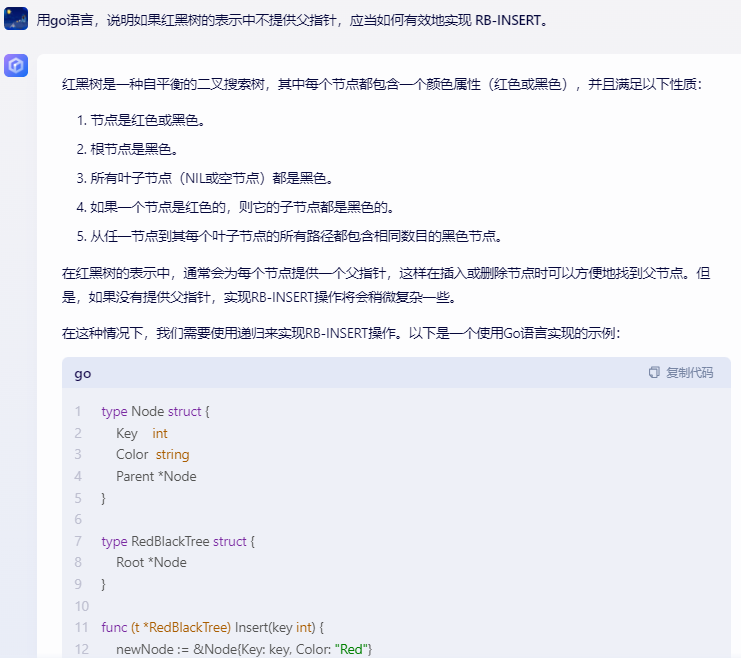
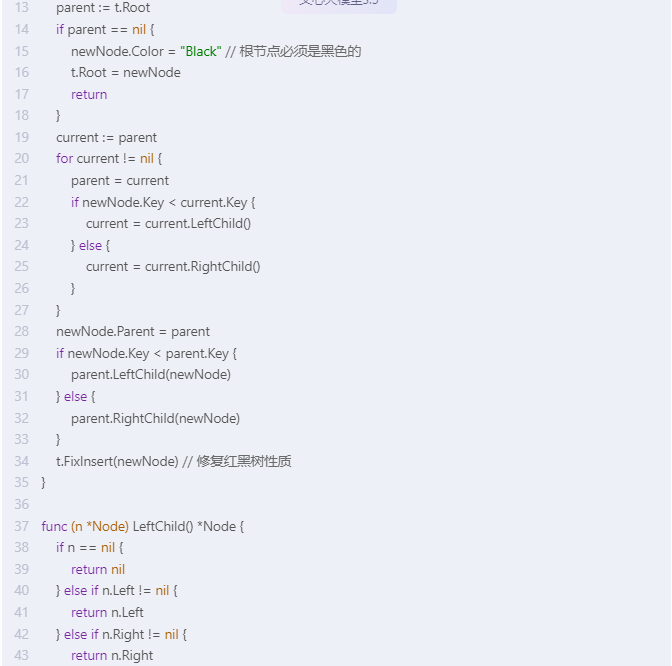
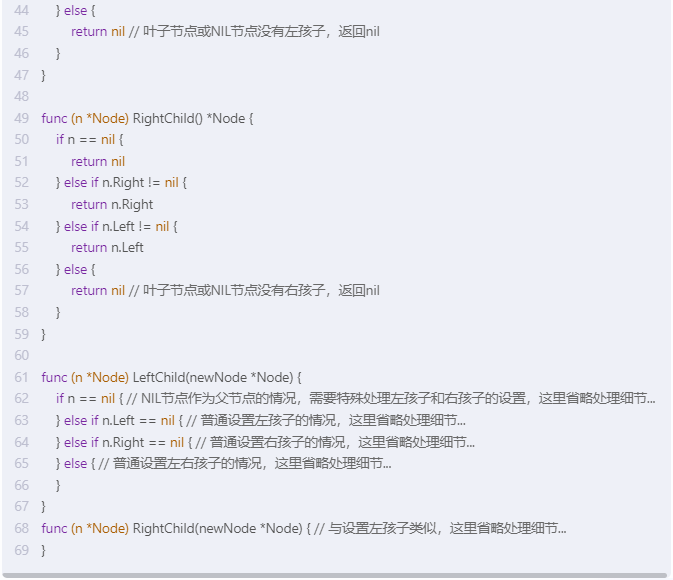




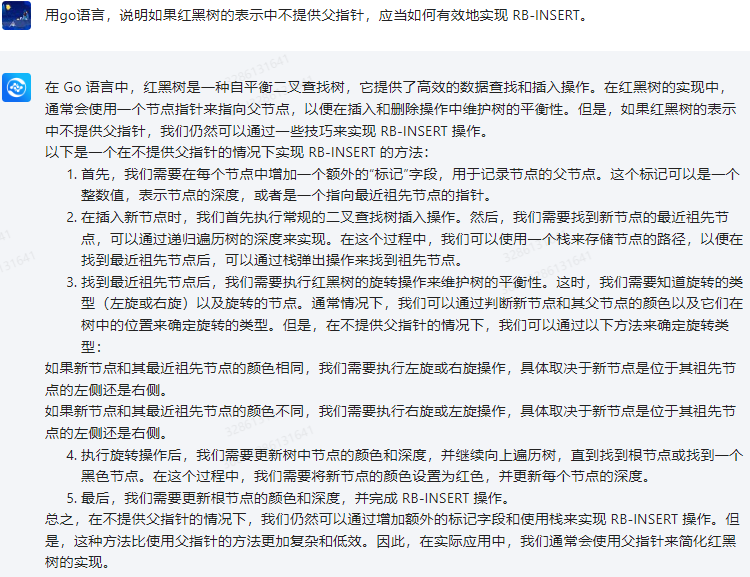
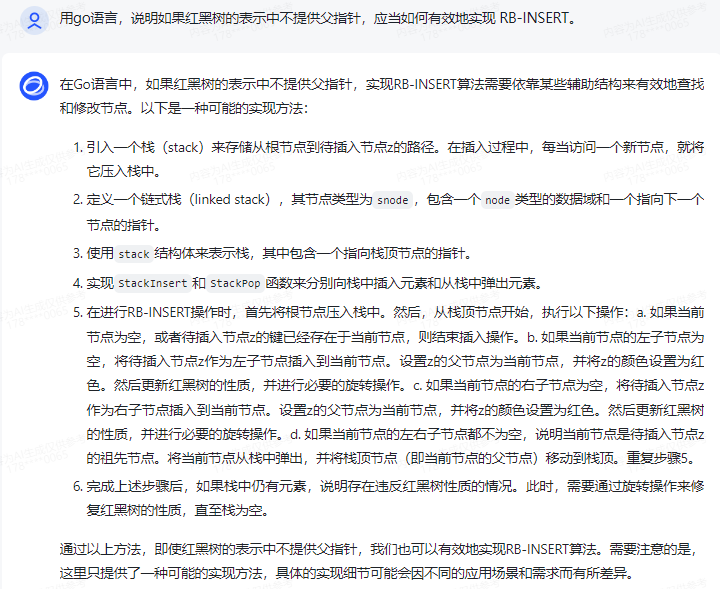
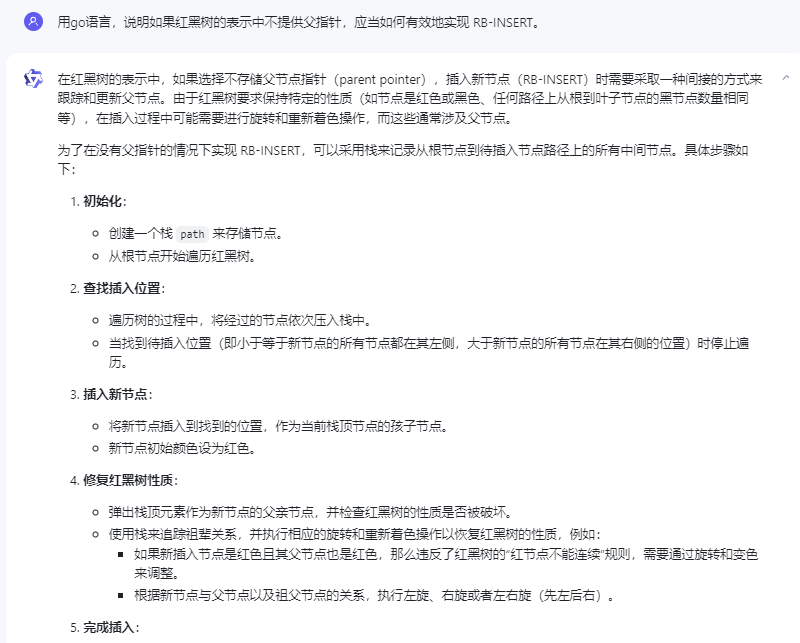
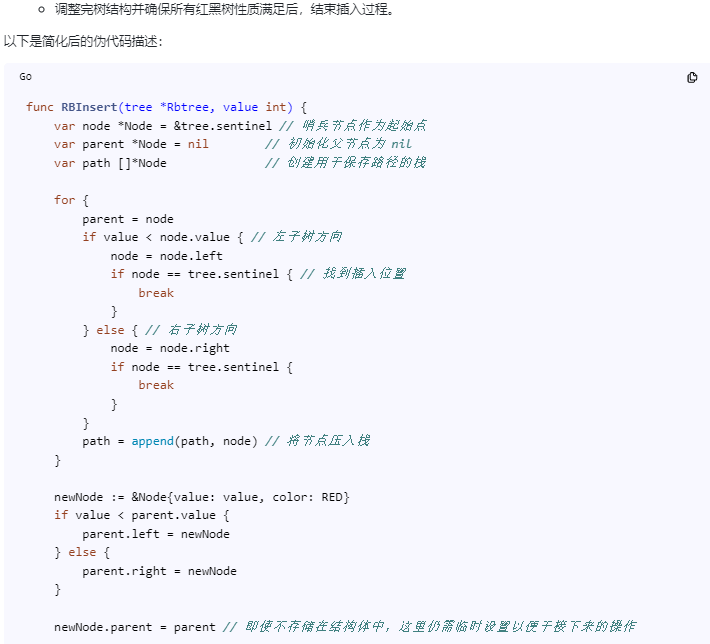
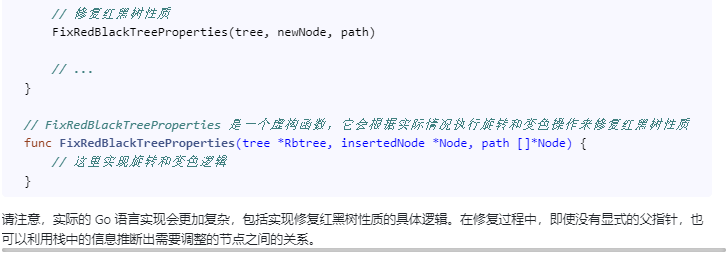
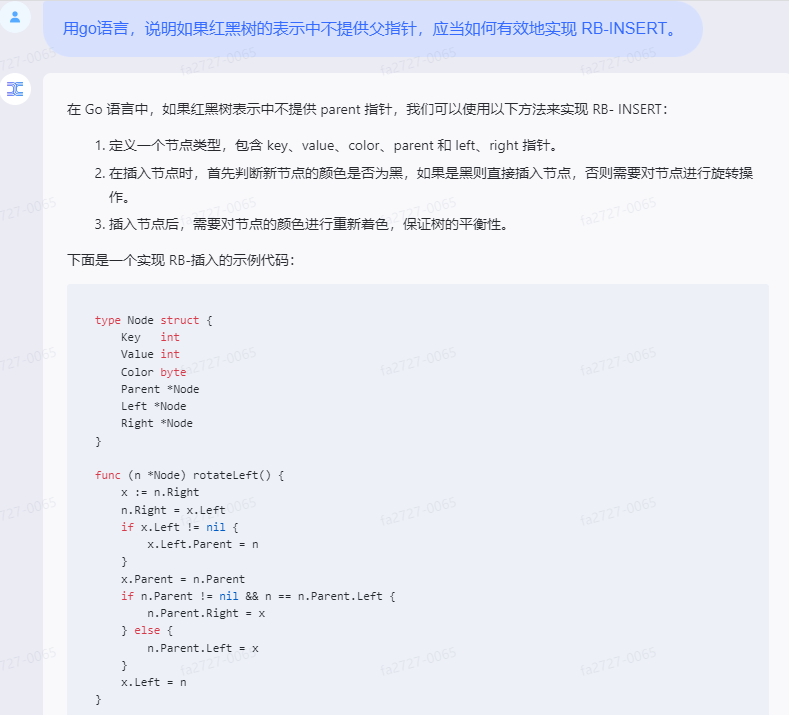
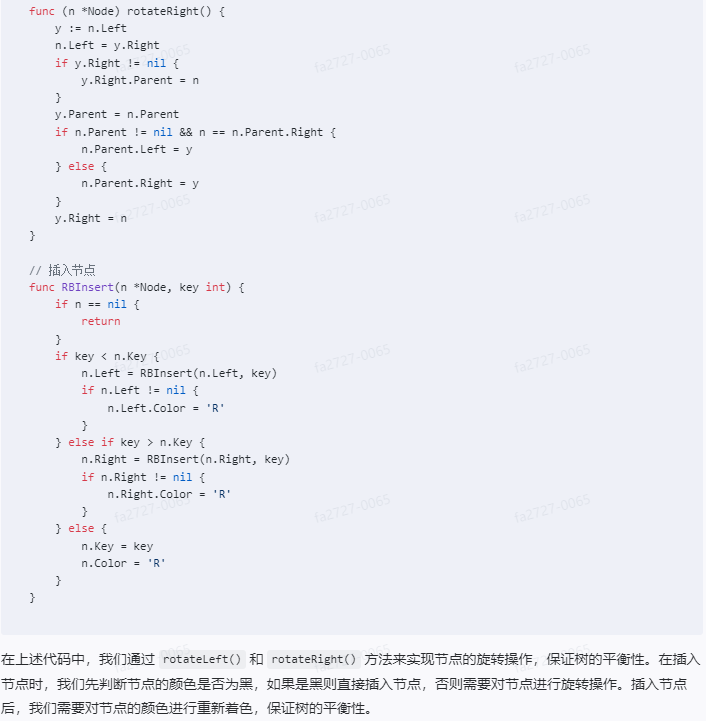
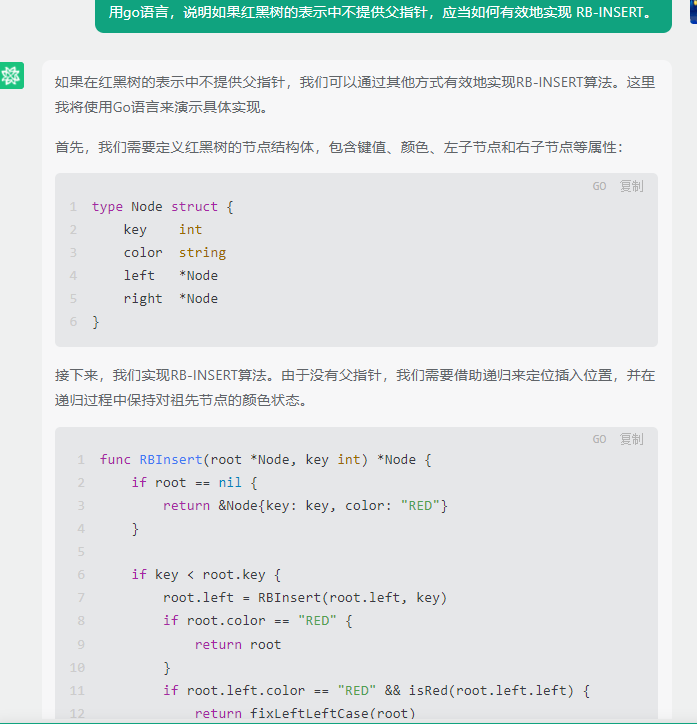
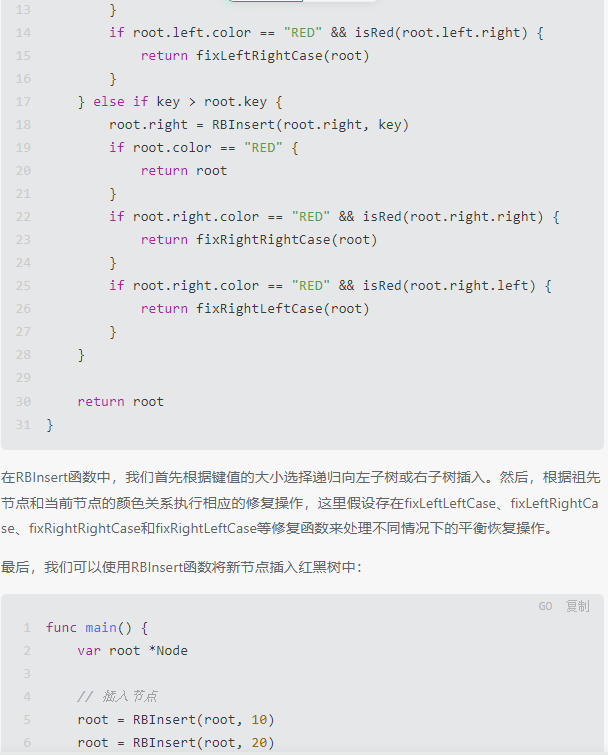
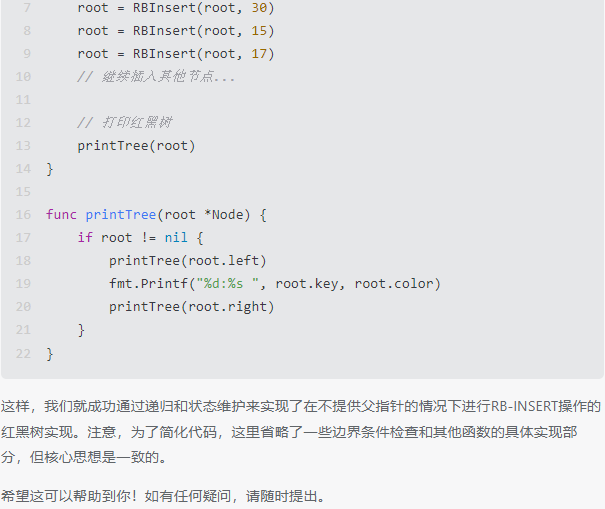

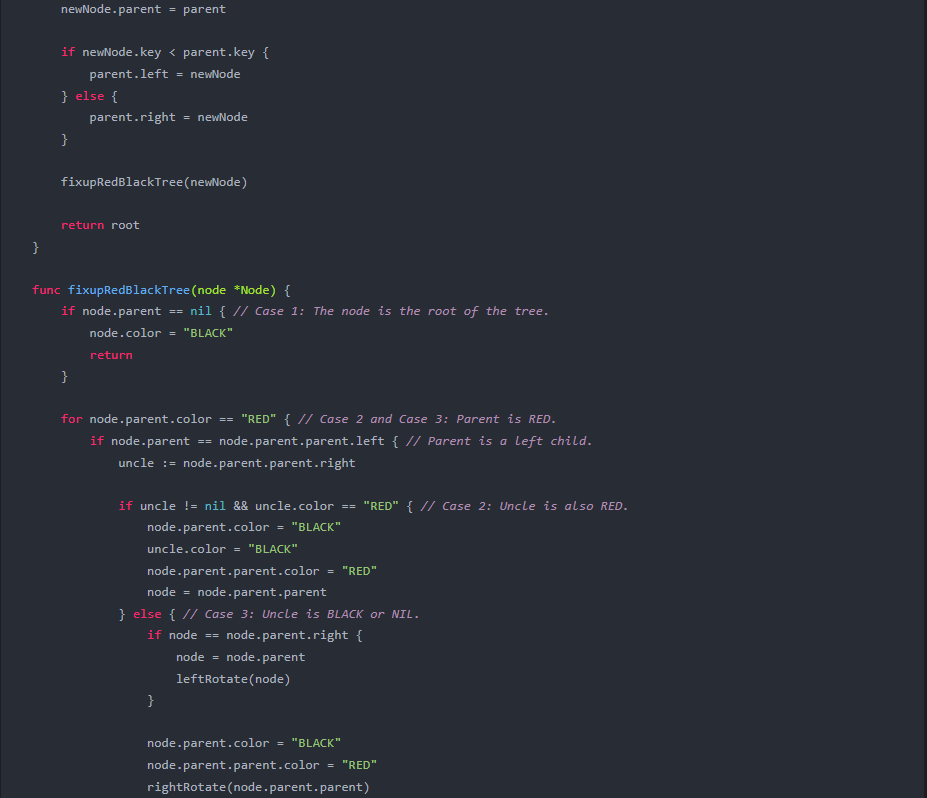

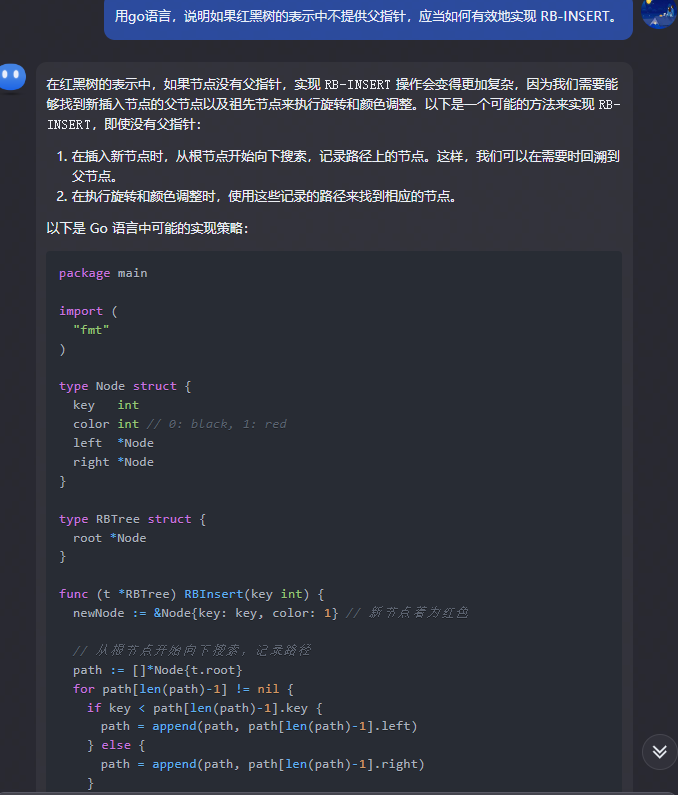
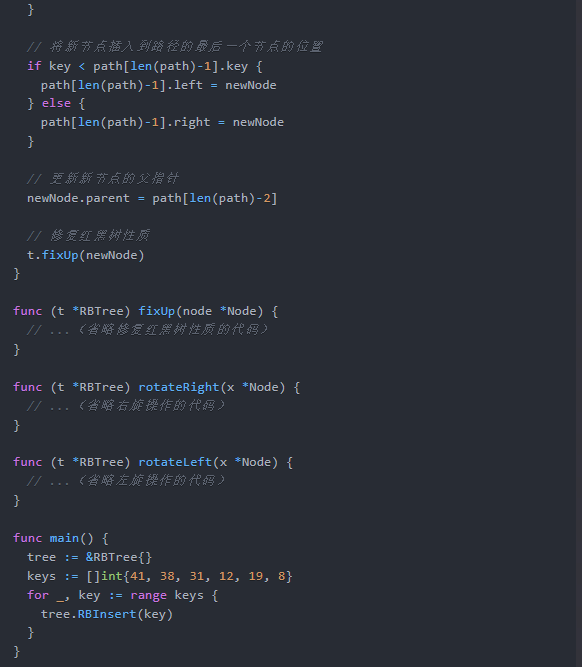

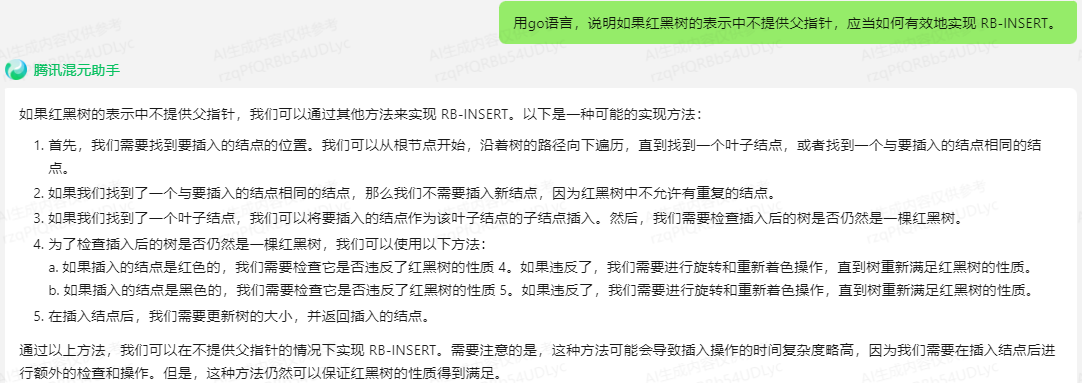








评论